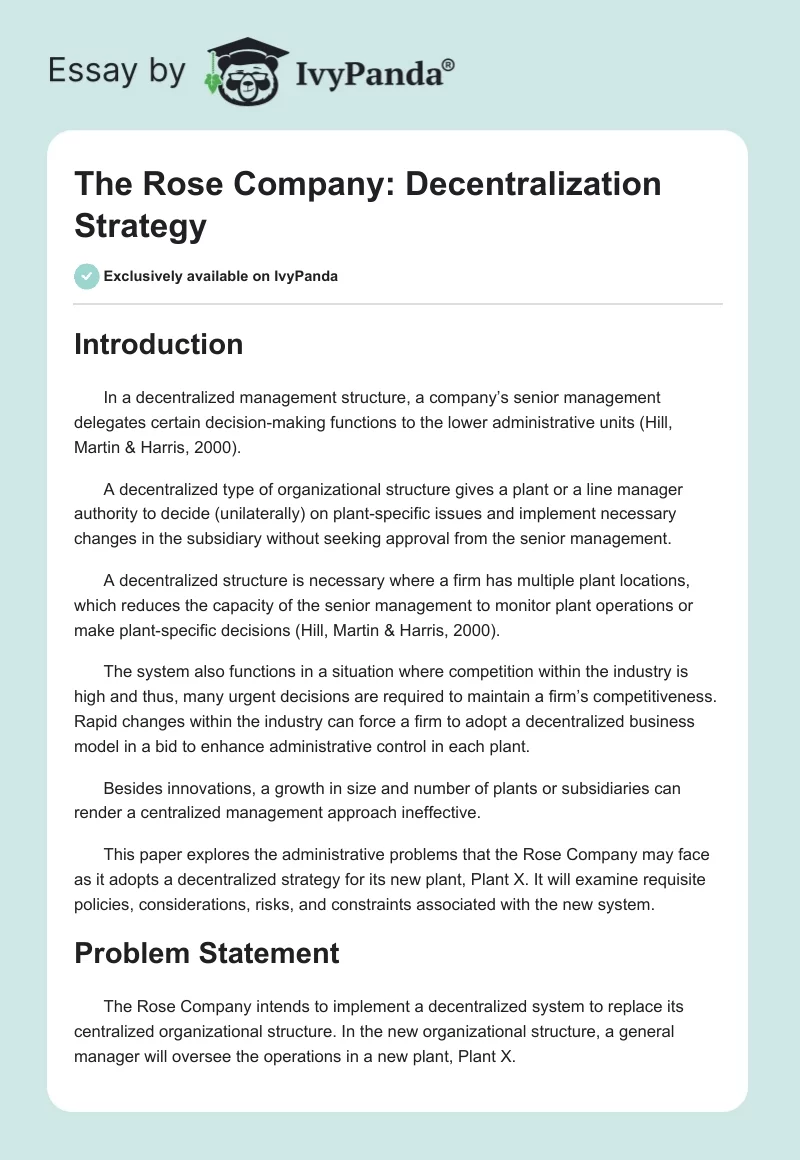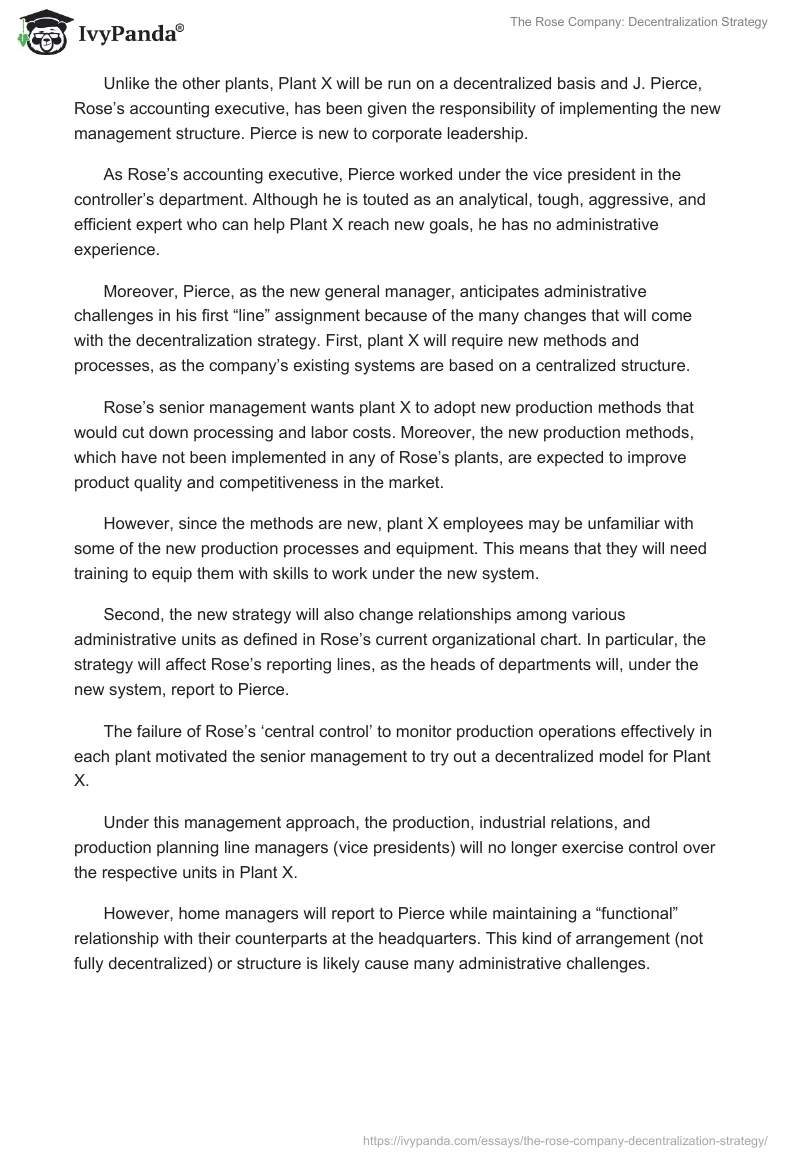Introduction
In a decentralized management structure, a company’s senior management delegates certain decision-making functions to the lower administrative units (Hill, Martin & Harris, 2000).
A decentralized type of organizational structure gives a plant or a line manager authority to decide (unilaterally) on plant-specific issues and implement necessary changes in the subsidiary without seeking approval from the senior management.
A decentralized structure is necessary where a firm has multiple plant locations, which reduces the capacity of the senior management to monitor plant operations or make plant-specific decisions (Hill, Martin & Harris, 2000).
The system also functions in a situation where competition within the industry is high and thus, many urgent decisions are required to maintain a firm’s competitiveness. Rapid changes within the industry can force a firm to adopt a decentralized business model in a bid to enhance administrative control in each plant.
Besides innovations, a growth in size and number of plants or subsidiaries can render a centralized management approach ineffective.
This paper explores the administrative problems that the Rose Company may face as it adopts a decentralized strategy for its new plant, Plant X. It will examine requisite policies, considerations, risks, and constraints associated with the new system.
Problem Statement
The Rose Company intends to implement a decentralized system to replace its centralized organizational structure. In the new organizational structure, a general manager will oversee the operations in a new plant, Plant X.
Unlike the other plants, Plant X will be run on a decentralized basis and J. Pierce, Rose’s accounting executive, has been given the responsibility of implementing the new management structure. Pierce is new to corporate leadership.
As Rose’s accounting executive, Pierce worked under the vice president in the controller’s department. Although he is touted as an analytical, tough, aggressive, and efficient expert who can help Plant X reach new goals, he has no administrative experience.
Moreover, Pierce, as the new general manager, anticipates administrative challenges in his first “line” assignment because of the many changes that will come with the decentralization strategy. First, plant X will require new methods and processes, as the company’s existing systems are based on a centralized structure.
Rose’s senior management wants plant X to adopt new production methods that would cut down processing and labor costs. Moreover, the new production methods, which have not been implemented in any of Rose’s plants, are expected to improve product quality and competitiveness in the market.
However, since the methods are new, plant X employees may be unfamiliar with some of the new production processes and equipment. This means that they will need training to equip them with skills to work under the new system.
Second, the new strategy will also change relationships among various administrative units as defined in Rose’s current organizational chart. In particular, the strategy will affect Rose’s reporting lines, as the heads of departments will, under the new system, report to Pierce.
The failure of Rose’s ‘central control’ to monitor production operations effectively in each plant motivated the senior management to try out a decentralized model for Plant X.
Under this management approach, the production, industrial relations, and production planning line managers (vice presidents) will no longer exercise control over the respective units in Plant X.
However, home managers will report to Pierce while maintaining a “functional” relationship with their counterparts at the headquarters. This kind of arrangement (not fully decentralized) or structure is likely cause many administrative challenges.
Analysis and Implementations
A decentralized structure removes some decision-making roles from the senior management and assigns them to line managers.
This improves the rate at which decisions are made since it eliminates unnecessary bureaucracy and administrative barriers. It also gives the top management time to formulate major strategies for the firm.
On the other hand, a decentralized organizational structure can hamper information sharing due to “procedural differences” between the line manager and the senior management (Watson, 2003, p. 307). This can create control and administrative problems in a company.
In this regard, before implementing a new restructuring strategy, the management should first define how the new approach would improve a firm’s operations and competitiveness (Wheelen & Hunger, 2002).
The senior management of the Rose Company wants to restructure its organizational structure by allowing its new plant to operate independently with regard to its manufacturing processes and personnel management.
The management arrived at a decision to start Plant X, which, unlike the others, will adopt new manufacturing processes and reporting structures. It is evident that Rose’s case raises concerns related to strategy implementation.
The central management of the Rose Company should take into consideration several factors when implementing the decentralization strategy. One of the key considerations is the policy framework to support the restructuring process.
Pierce needs to create an implementation plan that will guide the restructuring strategy. Following decentralization, manufacturing at Plant X will involve new processes and methods.
Thus, a framework that details the functional policies will ensure that the decentralized operations (manufacturing) run as expected. Pierce foresees challenges related to administrative relationships in the decentralized unit.
Pierce will perform administrative and management roles that relate to personnel in the Plant X. In the decentralized unit, line managers will cease to report to their respective vice presidents at the home office.
Instead, they will report to Pierce, as Plant X’s general manager. Thus, he needs to develop human resource policies to guide recruitment, staff training on the new processes, promotions, and dismissals.
In the Rose Co., certain risks and constraints may affect the implementation of the new strategy. Top among them is the management capacity of Plant X’s leadership.
Mr. Pierce has not been involved in administrative functions at Rose having served as the company’s accounting executive at the home office and thus, the assignment is new to him. Moreover, he has not worked at the new plant before.
He has no management experience, as the new job is his first major assignment. This presents a potential threat to the implementation of the new strategy. However, Pierce has excellent analytical and administrative capacity, which may prove essential in managing the new venture.
Another potential constraint relates to the partial “functional relationship” retained between Plant X’s line managers and their respective seniors in the home office. This system is likely to derail the decision-making process and restrict Pierce’s administrative powers.
Since in the old organizational structure the line managers were answerable to their respective senior vice presidents at the home office, they will continue to do so if the reporting lines are left open. Thus, the functional relationships that exist between the two levels pose a threat to the successful implementation of the decentralization strategy.
The new manufacturing methods and equipment will constrain Plant X’s operations. According to the report, Rose’s top managers were unsatisfied with the management of the company’s manufacturing operations. This motivated them to experiment with Plant X a new management approach and novel manufacturing methods.
It is important to note that the Rose Company has never tried out the decentralized model and the production processes and equipment in any of its plants. Thus, the organizational changes will need a complete overhaul of Plant X’s systems and retraining of staff about the new production methods.
It will require the installation of new equipment and changes in the product production process. Thus, resistance to the new changes will present a threat to the implementation of the strategy.
Recommendations
Based on the findings of this analysis, it is recommended that the management of the Rose Company undertake measures to enhance the restructuring process involving plant X.
The central management should restructure the current organizational chart to ensure that all reporting lines in Plant X end at the general manager.
All line managers, except sales manager, should report to Pierce. The functional relationships between the line managers and the vice presidents will affect decision-making and the implementation of the strategy.
The central management should also allow the decentralized unit to operate independently in order to explore its business environment and evaluate its capabilities (Kozami, 2002).
It should be allowed to source for its supplies and sell or distribute its products independently, which, in effect, means that Plant X will incur costs or reap the profits depending on how it runs its activities. In this regard, it is recommended that the sales function, which Pierce does not oversee, be allocated to plant X.
In this way, Pierce can exercise full control of the activities of the decentralized unit. The senior vice presidents in charge of purchases, quality control, traffic, and plant control, who retain a functional relationship with Plant X, should not participate in the unit’s decision-making process, as this will usurp Pierce’s administrative powers.
The authority of both the senior executives and the unit management should be separated for the new strategy to work.
The Rose Company will also need to enhance communication channels to facilitate information sharing between Plant X and the other units. Under the current structure, Plant X will not be able to relate horizontally with the other plants.
According to Wheelen and Hunger (2002), decentralization strategy induces a process of social learning and creates new forms of knowledge.
Thus, a policy that promotes horizontal cooperation will allow the new plant to communicate to the vice presidents in charge of production, industrial relations, and production planning the progress of the restructuring process.
It will create an atmosphere of interaction among Rose’s units, which will foster innovation and product improvement processes.
In addition, free transmission of knowledge will help the central management to understand “what is working and what is not working” in the decentralized unit and take appropriate steps (Aldrich, 2000, p. 45).
The knowledge transfer channels will serve as “best practice forums” that will allow the senior management to monitor the progress of the implementation process (Aldrich, 2000, p. 44).
Conclusion
A decentralization strategy can allow large firms to improve the management of its units. The Rose Company’s decentralization strategy will allow the firm to introduce and test new manufacturing processes and equipment at Plant X.
However, the retention of functional relationships between the line managers at Plant X and the senior vice presidents at the home office presents is a potential threat to the implementation process.
This paper has analyzed the considerations, policies, and risks and constraints associated with Rose’s current organizational structure. Recommendations on how the Rose Company can overcome these constraints and move from a centralized system to a decentralized structure for Plant X are also given.
References
Aldrich, H. E. (2000). Organizations Evolving. London: Sage.
Hill, S., Martin, R. & Harris, M. (2000). Decentralization, integration and the post-bureaucratic organization: the case of R&D. Journal of Management Studies, 37(1), 563–585.
Kozami, A. (2002). Business Policy and Strategic Management. New York: Tata McGraw-Hill Education.
Watson, T. (2003). Strategists and strategy-making: strategic exchange and the shaping of individual lives and organizational futures. Journal of Management Studies, 40(5), 305–323.
Wheelen, T. & Hunger, J. (2002). Strategic management and business policy. Upper Saddle River: Prentice Hall.


